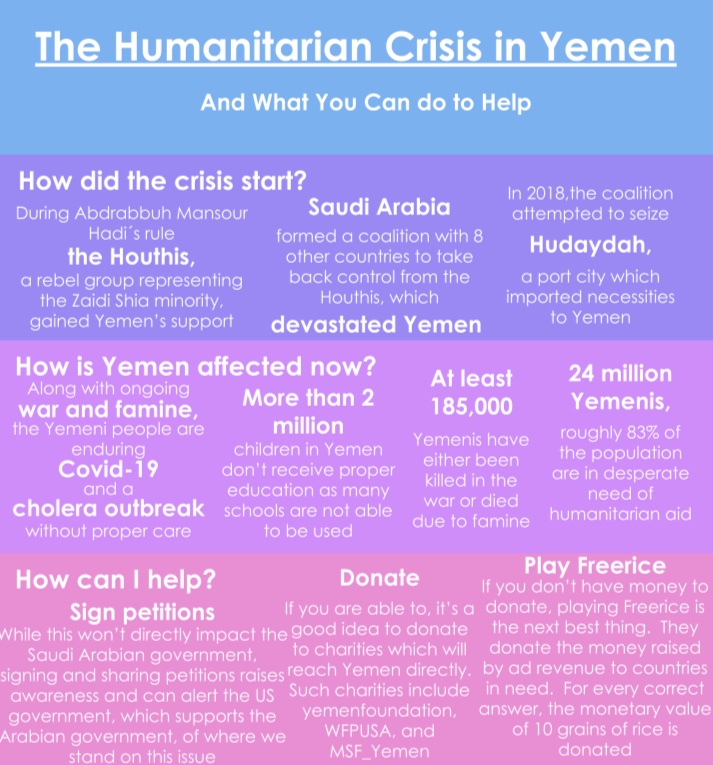by Samson Le and Arden Nguyen

For over five years, headlines from Yemen’s destructive civil war have flooded the news and shocked observers abroad. But what exactly is the situation in Yemen, and how did it start?
History
Ever since it was formed in 1990 by the unification of two smaller republics, Yemen has struggled with political, regional, religious and linguistic divisions. To make matters worse, upon Yemeni unification, Ali Abdullah Saleh became president, beginning a 20-year period of autocratic and corrupt rule.
In the early 2010s, the Arab Spring―a popular movement promoting pro-democracy ideas in protest of oppressive regimes in the Middle East―spread to Yemen. Saleh was forced to cede his power to his vice president, Abdrabbuh Mansour Hadi.
However, Hadi soon faced numerous issues involving unemployment, food insecurity, corruption and a separatist movement in the south of Yemen. Because of this, the Houthis, a rebel group representing the country’s Zaidi Shia minority and frustrated by their lack of representation in the new government, gained immense support from the Yemeni population.
As support for the Houthis grew, the rebels successfully managed to take over multiple regions and the capital of Sanaa in late 2014, causing Hadi to resign and flee the country in early 2015.
While Hadi was in exile, Saudi Arabia established a coalition with eight Arab states to support the restoration of his government, which is now situated in the southern city of Aden. Their military operations were and continue to be aided by the US, UK, and France. While the Saudi coalition and the Houthis exchanged attacks, Hadi’s coalition blockaded Yemen, causing an increase in food and fuel prices and worsening food insecurity.
In mid-2018, the coalition tried to seize the port city of Hudaydah from Houthi control, a dangerous move considering the city is of major importance to the survival of much of Yemen’s population.
After six months of fighting, both sides reached a ceasefire after negotiations in Sweden, referred to as the Stockholm agreement. It mandated that troops leave Hudaydah and that both sides should work out a system for prisoner exchange; however, only the latter has been addressed.
In mid-2019, the United Arab Emirates (one of Saudi Arabia’s allies) withdrew its forces from Yemen following criticism worldwide for its actions during the war. Meanwhile, the aforementioned separatist movement, known as the Southern Transitional Council (STC), began clashing with government forces.
In January of this year, clashes intensified between the Houthis and the coalition. In April, the STC proclaimed self-rule in Aden, which violated a peace agreement with the Yemeni government.
Current Situation
According to UNICEF, Yemen has been severely affected by not just the COVID-19 pandemic, but by a cholera outbreak that has affected over a million Yemenis. Only about half of the nation’s medical facilities are operating, with many facing a shortage of medical equipment and supplies. In April, Saudi Arabia called for a ceasefire due to the pandemic, but it was rejected by the Houthis.
Blockades remain in Sanaa and Hudaydah, keeping the prices of food and fuel relatively high, while Saudi airstrikes have killed thousands and destroyed many areas. As a result, twenty million Yemenis struggle with food insecurity and poverty.
Many are at risk of experiencing famine. Millions of children are unable to attend school. In total, over 24 million civilians (in a country of 29 million) are in desperate need of humanitarian aid and over 3.65 million people have been displaced.
Thousands of people have died from malnutrition, disease and other health problems. Thousands more have been killed or injured in the fighting as both the Houthis and Saudi coalition forces violate international law by targeting civilians.
The United Nations (UN) has requested more funding for Yemen, but pledges from nations worldwide have not been enough.
If you would like to help the UN World Food Programme supply food to Yemen, you can download the Freerice app or play games at freerice.com. You can also make a donation to organizations like the Yemen Relief and Reconstruction Foundation and Doctors Without Borders. Another option is signing this petition to call for an end to the humanitarian crisis.





